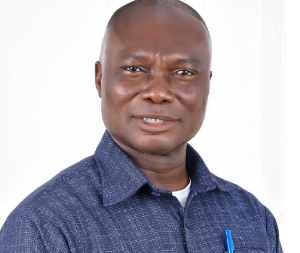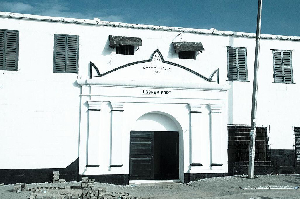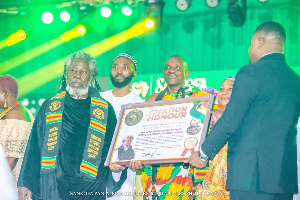The National Liberation Movement (NLM) was formed in 1954 as a "movement" for "national" (read Asante) liberation. Other names for the NLM include “Mate me ho” and “federation.” They initially did not consider themselves as a political party. Their link with Asante chiefs also served to bolster the arguments of their critics that NLM was a “secessionist movement.”
The dilemma to be a movement or a political party became evident in the 1955 by-election for the Atwima Nwabiagya constituency following the car accident death of the CPP parliamentarian, John Baidoo.
NLM decided not field their own candidate but to support B. F. Kusi as "an independent" candidate against CPP's B. K. Kufuor.
Kusi had been the CPP MP for that constituency in 1951, but lost out to John Baidoo in 1954 elections.
After Kusi won the 1955 by-election, NLM used that as part of their Janus-faced strategy: 1) challenge Nkrumah indirectly through appeals to Britain to derail the independence train; and 2) directly through a face-to-face confrontation at the polls and acts of violence and physical intimidations.
CMB was the creation of the colonial government in 1947 to siphon funds from the colonies to rebuild the war-shattered British economy after the WWII. The CMB was part of the Agricultural Produce Marketing Boards (cocoa, rubber, palm oil, groundnuts, and cotton) that the British created to sell agricultural produce of the colonies in the dollar zone to raise money resuscitate its war-shattered economy.
The Pioneer of September 7, 1954 reported:
“Ashantis, predominately [sic] farmers of Kumase and its neighbouring villages swore an oath never to accept the Government's general policy toward Ashanti, and inaugurated a non-political Association of all Ashanti youth at a large meeting .... declared its aim as being in the main a united front against the CPP government's ruling on the cocoa price.”
Bafuor Akoto, the rally’s keynote speaker, complained that the government had consistently slighted Asante in the issuing of government scholarships, as well as in the allocation of development schemes - despite the fact that “the revenue of the Government was obtained largely from the cocoa produced by Ashanti.”
The threat to Asante chiefs who rallied in support of the NLM was not because cocoa money was being used to “develop the north where they did not grow cocoa,” as the NLM claimed in their leaflets.
The threat to the Asante chiefs, and for that matter all chiefs in the country who had been used by the British in their indirect rule called the "Native Authority" system, was the passage of 1952 State Councils Ordinance. This ordinance curtailed the powers of chiefs drastically as power at the local level was shifted to local, urban and municipal councils. This was to extend adult suffrage and participatory democracy to the local level through the ballot box rather than local leadership being selected on the basis of one’s hereditary membership in a “royal” family.
Witness the present situation where Kumasi Metropolitan Assembly, the Regional Minister, and the Kumasi DCE are the ones responsible for carrying out development projects in Kumase and Ashanti Region, yet the Asantehene wants to go around inspecting progress being made on such projects. The substance of the chiefs’ power - including the levying of the local rate (lampool), and trying cases in the royal courts - was passed on to the new local, urban, and municipal councils. That was what the chiefs and their surrogates were fighting against. Cocoa price became a convenient excuse to rally the support of the rural farmers.
The cocoa excuse then and now goes to show how Ghanaians view the disparity between the north and south. The success of cocoa is partly due to the northern labour that got used in “abusa” and “afenhyia apadie” (annual sharecropping arrangement). The northerners who escaped the labour conscription of the colonial administration for public works, sought refuge on cocoa farms of the south. In several cocoa towns there are significant zongos. Take for example, Agona Nyakrom, Agona Nsaba, Agona Kwayarko, Agona Swedru. Cocoa’s success in Ghana was the result of the contributions of resources (land, labour, and capital) of the north and south. Yet narrow-minded people, claiming unfounded “divine right to rule” would not want equitable distribution of development projects throughout the country.
Yes, Ashanti and Brong Ahafo were the virgin forest frontier in the development of cocoa industry in the country in the 1940s and 1950s, Ashanti was not the only producer of cocoa and, therefore, the wealth of the nation.
In the 1930s, for example, the southern areas of present day Eastern, Central (then part of the Colony), and northern sections of Volta Region were the frontier forest areas for the expanding cocoa farms that had started in the Akwapim Hills. The cocoa boycotts of the 1930s were essentially a phenomenon in the Colony.
Asantes during the 1930s were pre-occupied with the restoration of the Asante Confederacy Council (now known as Asanteman Council) that had been abolished by the British after the 1896-1900 British-Asante Wars. After these wars, Britain annexed Ashanti in 1901, but the British ruled Ashanti indirectly through the chiefs. Even though Prempeh I had been allowed to return from exile in 1924, he was in 1926 restored by the colonial rulers as Kumasihene, not Asantehene. It was not until Prempeh II was enstooled that the British recognized him as the Asantehene in 1935.
The 1920s marked a period of state-led economic development during the governorship of Guggisberg to open up the country. The extension of railways and motor roads to Kumasi and other parts of the country expanded economic opportunities to the enterprising ones who used their newly economic means to challenge the power of the chiefs in various local communities. In Ashanti, the enterprising young ones – popularly known as nkwankwaa – staged an important, though unsuccessful, hold-up of cocoa in response to the machinations of the AWAM merchants led by UAC. In response to the growing challenge that the nkwankwaa posed to chiefly authority, the British colonial rulers decided to centralize the chiefly authority by restoring the Asante Confederacy Council in 1935 and thus restored and recognized Prempeh II as the Asantehene.
Allman (1993, p. 31) writes, “Some of the youngmen of Kumase, perhaps in an effort to tear apart the recently restored confederacy, then collaborated with the Dadesoabahene, Bantamahene, Akyempemhene, Adumhene, Nkosonhene, and Akyeamehene, in a plot to remove the Asantehene, Prempeh II, from the Golden Stool. The conspiracy was quickly uncovered, but the fact that ‘irresponsible agitators’ could win the support of such prominent chiefs required drastic action. Less than a year later, during 1936, the council took matters into its own hands: in response to the nkwankwaa’s vocal opposition to the colonial government’s reconstitution of the confederacy, their reluctance to perform various communal services, and their role in the destoolments of so many paramount chiefs, including the attempt to destool the Asanthene, the Asante Confederacy Council abolished the office of Nkwankwaahene (leader of the youngmen) and all nkwankwaa organizations.” The position of the Nkwankwaahene is non-hereditary (esom adwa – service stool), therefore, the position can be dispensed with. But the nkwankwaa would not go away.
The nkwankwaa is another term for the asafo, commoners, or the ruled. There can be no ruler without the ruled. But the ruler must be accountable to the ruled, therein is the source of conflict. In Ashanti, the nkwankwaa reconstituted themselves into the Asante Youth Association (AYA) which was founded in 1947.
Allman (1993, p.32) describes the AYA members thus: “No longer rooted primarily in petty trade and small-scale rubber production, the youngmen of post-World War II period wer an economically diverse lot. Most had attained some degree of education, which led them into such burgeoning occupations as journalism, teaching, accounting, and clerking. Some were ```shopkeepers and small-scale traders, and some were involved in cocoa production, if only in small way. Though many were related to chiefs, they had no realizable aspirations to chiefly office. They can also be distinguished from the old guard intelligentsia – the relatively sparse, though politically significant group of Asante professionals like K. A. Busia and I. B. Asafu-Adjaye [one may add names like Joe Appiah and Victor Owusu, and by extension, J. B. Danquah, Akuffo Addo, and Ofori Atta] who had been trained to inherit the government upon the departure of the British, but who had been left out after the dynamic rise of the CPP.”
Many of the nkwankwaa who formed AYA including Kusi Ampofu, Osei Asibey-Mensah, Sam Boateng (of Union Government fame) were instrumental in forming CPP in 1949. Some of these people would break away from CPP over the issue of allocation of seats to the Legislative Assembly and the selection of candidates for the 1954 elections. These former CPP members became the vanguard of the NLM.
Ironically, the selection of party candidates for parliament is still a thorny issue for many a party in the country today.
** Sources: Jean Marie Allman (1993), The Quills of the porcupine; Denis Austin (1967), “Opposition in Ghana: 1947-1967” in Government and Opposition, Vol 2, Number 4: 539-55; and David Apter (1968), “Ghana in Transition;” and Gwendolyn Mikell (1992), “Cocoa and chaos in Ghana.”















